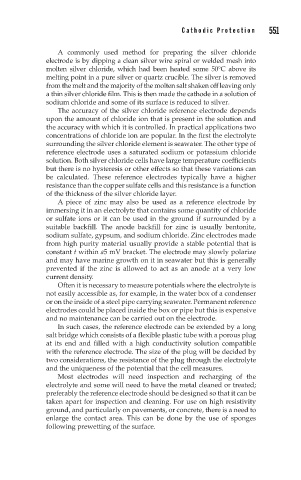Page 588 - Corrosion Engineering Principles and Practice
P. 588
550 C h a p t e r 1 3 C a t h o d i c P r o t e c t i o n 551
A commonly used method for preparing the silver chloride
electrode is by dipping a clean silver wire spiral or welded mesh into
molten silver chloride, which had been heated some 50°C above its
melting point in a pure silver or quartz crucible. The silver is removed
from the melt and the majority of the molten salt shaken off leaving only
a thin silver chloride film. This is then made the cathode in a solution of
sodium chloride and some of its surface is reduced to silver.
The accuracy of the silver chloride reference electrode depends
upon the amount of chloride ion that is present in the solution and
the accuracy with which it is controlled. In practical applications two
concentrations of chloride ion are popular. In the first the electrolyte
surrounding the silver chloride element is seawater. The other type of
reference electrode uses a saturated sodium or potassium chloride
solution. Both silver chloride cells have large temperature coefficients
but there is no hysteresis or other effects so that these variations can
be calculated. These reference electrodes typically have a higher
resistance than the copper sulfate cells and this resistance is a function
of the thickness of the silver chloride layer.
A piece of zinc may also be used as a reference electrode by
immersing it in an electrolyte that contains some quantity of chloride
or sulfate ions or it can be used in the ground if surrounded by a
suitable backfill. The anode backfill for zinc is usually bentonite,
sodium sulfate, gypsum, and sodium chloride. Zinc electrodes made
from high purity material usually provide a stable potential that is
constant t within a5 mV bracket. The electrode may slowly polarize
and may have marine growth on it in seawater but this is generally
prevented if the zinc is allowed to act as an anode at a very low
current density.
Often it is necessary to measure potentials where the electrolyte is
not easily accessible as, for example, in the water box of a condenser
or on the inside of a steel pipe carrying seawater. Permanent reference
electrodes could be placed inside the box or pipe but this is expensive
and no maintenance can be carried out on the electrode.
In such cases, the reference electrode can be extended by a long
salt bridge which consists of a flexible plastic tube with a porous plug
at its end and filled with a high conductivity solution compatible
with the reference electrode. The size of the plug will be decided by
two considerations, the resistance of the plug through the electrolyte
and the uniqueness of the potential that the cell measures.
Most electrodes will need inspection and recharging of the
electrolyte and some will need to have the metal cleaned or treated;
preferably the reference electrode should be designed so that it can be
taken apart for inspection and cleaning. For use on high resistivity
ground, and particularly on pavements, or concrete, there is a need to
enlarge the contact area. This can be done by the use of sponges
following prewetting of the surface.

